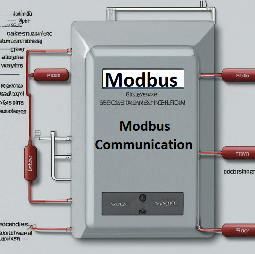Modbus: A Versatile Communication Protocol for Industrial Automation – Discover how Modbus enables seamless communication between devices in industrial automation systems.

Modbus Communication: A Comprehensive Guide
Modbus is a widely used communication protocol in industrial automation and control systems. Developed in 1979 by Modicon (now Schneider Electric), Modbus has become a standard for communication between devices in various industrial applications due to its simplicity, reliability, and ease of integration. This article provides an in-depth look at Modbus communication, including its history, operation, variations, and practical applications.
1. Introduction to Modbus
Modbus is a serial communication protocol designed to facilitate the exchange of data between devices in a network. It allows devices such as sensors, actuators, and controllers to communicate with each other over a serial or network connection. The protocol is known for its open and straightforward design, making it accessible and adaptable for a wide range of applications.
2. How Modbus Works
Modbus operates on a master-slave (or client-server) architecture:
- Master Device: Initiates requests for data and controls the communication flow. Typically, this is a PLC or a computer-based control system.
- Slave Devices: Respond to requests from the master device. These are usually sensors, actuators, or other control devices.
Communication in Modbus involves the following components:
- Messages: Modbus communication is conducted through messages that include function codes, addresses, and data. Each message follows a specific format to ensure proper interpretation by both master and slave devices.
- Function Codes: Define the type of action requested or performed, such as reading or writing data. Function codes help the master and slave devices understand the purpose of the communication.
- Data Units: The actual data being transmitted between devices. This can include status information, control commands, or measurement values.
3. Modbus Variants
Modbus comes in several variants, each suited for different communication needs:
- Modbus RTU (Remote Terminal Unit):
- Communication Medium: Serial communication over RS-232 or RS-485.
- Data Representation: Binary format, which is compact and efficient.
- Error Checking: Uses cyclic redundancy check (CRC) for error detection.
- Modbus ASCII:
- Communication Medium: Serial communication over RS-232 or RS-485.
- Data Representation: ASCII format, which is human-readable but less efficient than RTU.
- Error Checking: Uses longitudinal redundancy check (LRC) for error detection.
- Modbus TCP/IP:
- Communication Medium: Ethernet network.
- Data Representation: Encapsulates Modbus messages within TCP/IP packets.
- Error Checking: Relies on TCP/IP’s built-in error checking and correction.
4. Applications of Modbus
Modbus is widely used in various industrial applications, including:
- Process Control: Connecting sensors, actuators, and controllers in manufacturing and process industries.
- Building Automation: Integrating HVAC systems, lighting controls, and other building management systems.
- Energy Management: Monitoring and controlling energy usage in electrical grids, solar power systems, and other energy-related applications.
5. Advantages of Modbus
Modbus offers several advantages that contribute to its popularity:
- Simplicity: The protocol’s straightforward design makes it easy to implement and understand.
- Interoperability: As an open standard, Modbus is compatible with a wide range of devices and manufacturers.
- Flexibility: Modbus supports various communication media and formats, making it adaptable to different needs.
- Cost-Effectiveness: The protocol’s open nature and widespread use reduce implementation costs.
6. Challenges and Considerations
While Modbus is a robust and versatile protocol, it does present some challenges:
- Limited Data Size: Modbus is typically used for relatively small amounts of data, which may be limiting for applications requiring large data transfers.
- No Native Security: Modbus does not include built-in security features, making it vulnerable to unauthorized access. Additional security measures, such as firewalls and encryption, may be needed.
7. Future Trends
Modbus continues to evolve to meet the demands of modern industrial systems:
- Modbus Over IP: Increased use of Modbus TCP/IP in Ethernet networks supports higher data transfer rates and integrates with other network technologies.
- Enhanced Security: Ongoing efforts to address security concerns through updates and enhancements to the protocol.
8. Conclusion
Modbus communication remains a cornerstone of industrial automation, valued for its simplicity, reliability, and versatility. By understanding its operation, variants, and applications, organizations can effectively leverage Modbus to enhance their automation systems and achieve greater control and efficiency in their operations.
Whether you’re implementing a new system or maintaining an existing one, Modbus offers a tried-and-true solution for connecting and managing industrial devices.
Home | Join us on Facebook, Twitter, YouTube, Instagram, Quora, Reddit, LinkedIn, Pintereset, Blogger.